Has anyone ever posted measurements of his or her hearing?
Do keep in mind that these only test 1 of our 2 hearing systems, and are simple pure tones. The result is a measure of how well you perceive simple tones. They are useful, show in one way how people's hearing may differ, but are somewhat limited.
dave
I did not say that, It is a useful tool. Just not sufficient by itself. I think i have made that pretty clear.
dave
No you did not make that clear. You made it look like frequency response would be meaningless. It is not. It is probably the one measurement that has the highest correlation to what we hear.
If I ran a sine wave into a Behringer 2031p at fb - it would handle that frequency ok. If I took a distributed slit vent Karlson 12 and ran sine at fb- say one watt, there would be a hoard of harmonics greater than the fundamental - just the way very small distributed vents behave. On "a lot of genre" - especially those employing acoustic instruments the Karlson with decent 12" fullrange or coaxial would appear to sound "better" imo. A single vent vs distributed holes or slits would fix the sine behavior and reduce distortion from that viewpoint perhaps 20dB. There may be cases where the lossy distributed vent is subjectively better. (They were faddish in the middle 1950's) An adjustable enclosure vent might be useful for the finnicky.
I've tuned a 3.5 cubic ft. reflex with 43-3/8" diameter holes - besides the harmonics, it made a great fan with a 15" woofer and only ten watts input.
some people record their speakers and compare the recording with direct wav/etc. file
I've tuned a 3.5 cubic ft. reflex with 43-3/8" diameter holes - besides the harmonics, it made a great fan with a 15" woofer and only ten watts input.
some people record their speakers and compare the recording with direct wav/etc. file
ome people record their speakers and compare the recording with direct wav/etc. file
A good test is to do that over and over and see how many generations it takes for the distortion or IR to go to crap. For a speaker with a lot of ringing, any sort of percussive sound will be bad after 2 generations as it will be mush. A speaker with clean IR can survive maybe 5 generations. A speaker with 15% HD at some value can go maybe 3 generations before HD is dominates. But if it is primarily 2nd order HD, it might sound "better'" to some people.
You made it look like frequency response would be meaningless.
I made it look like conflicting FR of the same driver are not all that meaningful. And even the good ones certainly not sufficient to quantify the performance of a driver by itself.
dave
for the purpose of sharing and attempt to convey something about a speaker's "sound" over the internet, if not a true metric, which could be contained within a forum or YouTube, one might include:
outdoor response (if possible), on axis and at a couple of relevant horizontal off axis points, plus a floor/ground plane.
(optional) two tone distortion at an appropriate to design playback level capabilities and low end cutoff frequencies.
indoor impulse
music track performance - that could be tricky due to copyright and room reverberant issues - I'm interested in human voice, percussion, dynamic bass tracks such as slapped upright bass viola, bowed bass viola - the usual stuff which is generated by a human and an acoustic instrument. The room will have influence but that's a "given" and the listener will use headphones. It could be misleading either by nature or by intentional bias but better than nothing imo.
or we can just say its good - not so good - great - good for what it is
outdoor response (if possible), on axis and at a couple of relevant horizontal off axis points, plus a floor/ground plane.
(optional) two tone distortion at an appropriate to design playback level capabilities and low end cutoff frequencies.
indoor impulse
music track performance - that could be tricky due to copyright and room reverberant issues - I'm interested in human voice, percussion, dynamic bass tracks such as slapped upright bass viola, bowed bass viola - the usual stuff which is generated by a human and an acoustic instrument. The room will have influence but that's a "given" and the listener will use headphones. It could be misleading either by nature or by intentional bias but better than nothing imo.
or we can just say its good - not so good - great - good for what it is
Last edited:
I made it look like conflicting FR of the same driver are not all that meaningful.
Err, no. As far as I can tell that's not what you did.
And even the good ones certainly not sufficient to quantify the performance of a driver by itself.
dave
Add distortion measurements and then you have properly quantified the performance of a driver. How to interpret that data is a completely different topic.
In the early 1970's, I had a cottage industry loudspeaker business. In 4 years, a hundred or so pairs of speakers were built, mostly 3 way, 12 inch suspended.Has anyone ever posted measurements of his or her hearing?
They usually were sold locally and a major feature was that I would come to the buyer's house with test gear and set them up for best room location and response using the owners amp and equalizer (everyone had an equalizer in the 70's.)
It was a great experience and I quickly learned several things.
First, equalizers usually ended up with the bass and treble levers pushed all the way up along with the mid-range and the levers on each side neutral. Call it the flying seagull arrangement.
Second, most of my customers were 35 to 65 year old men and after sweeping the tone generator I realized that 25% had no need for a tweeter at all. They would watch the dial on the generator hit 6000 and wonder why the speakers failed. At 15,000, their wives and daughters would come in holding their ears yelling, "Dad, what is that screeching sound?"
About half my customers wore glasses. That meant that their eyes were out of whack. I had no reason to believe that their ears were any better. A whole lot of construction workers, pilots and truck drives come with their own built in 24 db/octave high frequency filter.
Third, even though all the speakers were the same, in different rooms, they sounded substantially different. A lot different. Mostly in the woofer range, but mid-ranges could become strident and tweeters dull (or shrill.)
My salesman and I and friends did a lot of testing. I even built an anechoic chamber in my basement with boxes of acoustic foam left over from a recording studio that I helped design while engineering (mechanical-mostly to make it quieter.) We would exchange components and could usually hear a difference, but seldom could agree if it was an improvement. And it really didn't make much difference since the room that it was going to end up in and the equalizer that was going to control it were orders of magnitude more consequential.
It was pretty hard to get excited about a 1/4 db change in frequency response when in real world conditions, it might deviate by 15 db.
Just my two bits in this exact sport of speaker building.
even though all the speakers were the same, in different rooms, they sounded substantially different. A lot different. Mostly in the woofer range, but mid-ranges could become strident and tweeters dull (or shrill.)
What's causing these colorations in your opinion? How to get rid of it? Is this something that can be measured?
Thanks for playing along. You have nice measurements frequency wise and HD wise. But the one thing you have is a lot of acoustic 'after taste' due to the impulse response ringing - corresponding to the two cone breakup peaks above 10kHz that the A7.3 is known for. I think percussive sounds will have a shimmer and voices will have a sibillant quality. As I recall, this driver behaves better 15 deg off axis where these peaks go down. However, this acoustic aftertaste may actually be pleasing sounding to some - I believe this acoustic aftertaste makes soft impulses more audible. What this means is that it gives an apparent enhanced audibility of soft sharp sounds that otherwise is not there in the original recording. Some folks may call this "enhanced detail", or it might be the same as DDR to some? This seems to be more common in aluminum diaphragms.
If we look at the comparison between the A7.3 and the TC9FD's impulse response as previously seen here:
http://www.diyaudio.com/forums/full-range/267966-why-bother-frs-5.html#post4184730
Here is the A7.3 IR from pnix's measurements, it looks very similar to your IR:
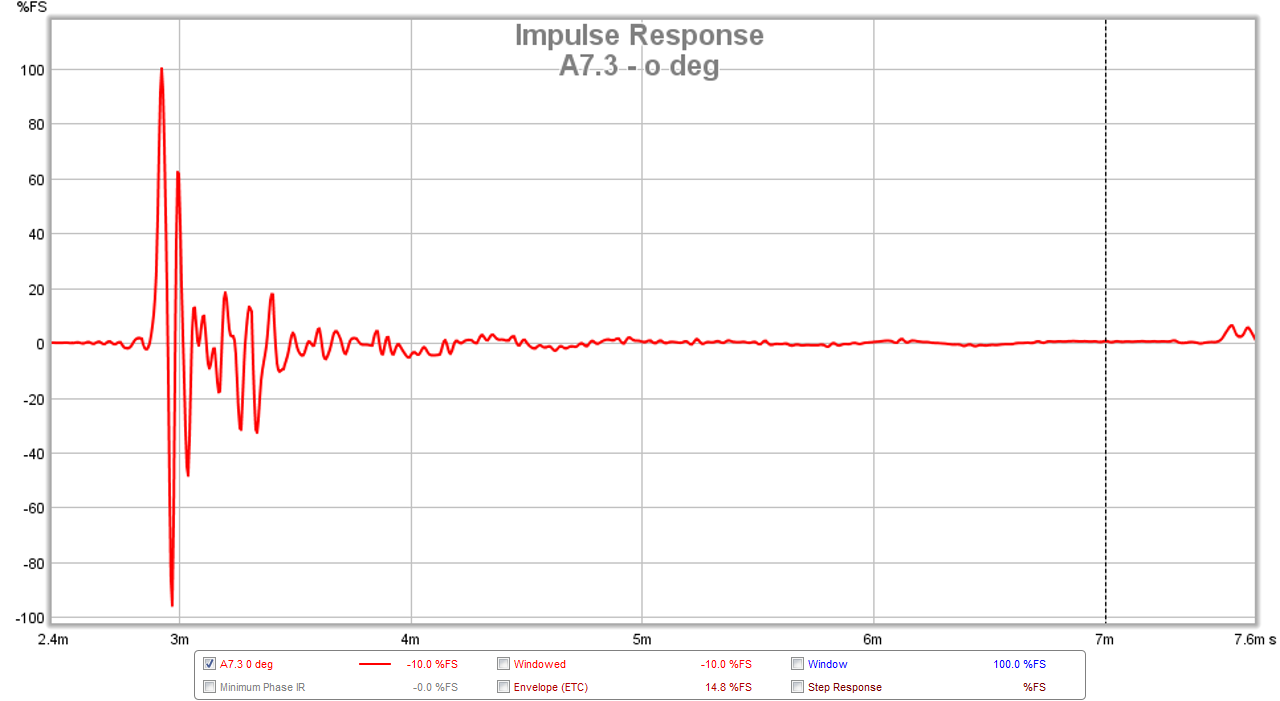
Here is the IR from your measurement:
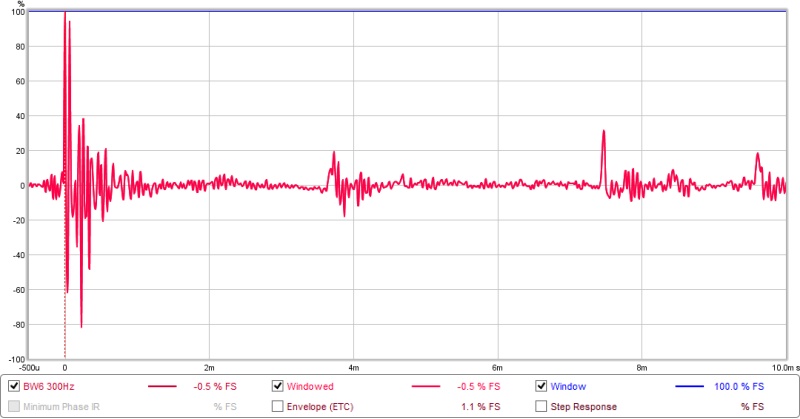
Here is the TC9FD's IR:
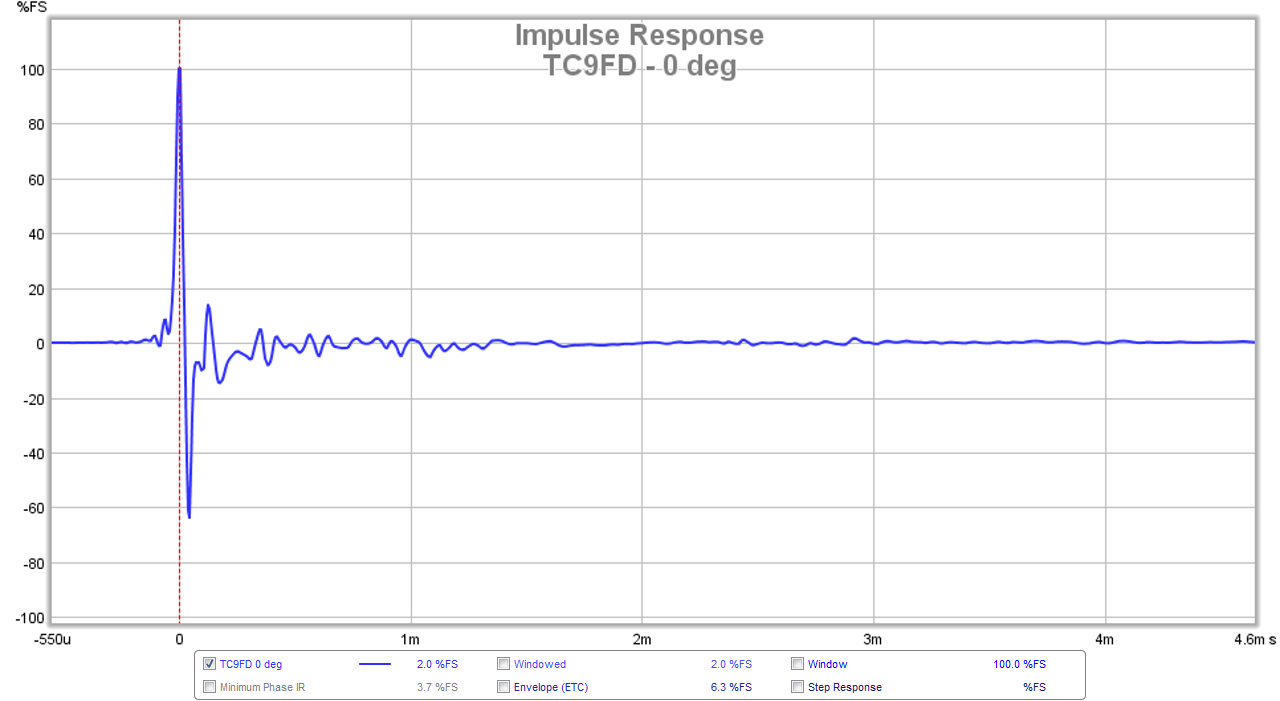
Now listen to what an impulse response sounds like from each driver, which one persists longer and is more audible?
A7.3 IR wav file:
http://www.diyaudio.com/forums/attachments/full-range/459100d1421174504-why-bother-frs-a7.3-sound-impulse-0-15-30-deg.zip
TC9FD IR wav file:
http://www.diyaudio.com/forums/attachments/full-range/459101d1421174504-why-bother-frs-tc9fd-sound-impuls-0-15-30-deg.zip
A7.3 appears to have edge reflection as root cause for peaking above 9kHz.
This is suggested by burst testing.
Flatter profile of A7.3 relative to Vifa also causes stronger reflections from front of magnet that radiate back through driver membrane.
Apparently no one seems to have read the post that accompanied the IR plot. The measurement was made in a resonant room at 2.5m!! The spike @ ~4ms is floor/ceiling bounce, the spike @ ~8ms is reflection off of the back wall. One question I do have is why does my IR settle twice as fast as pnix's?
Bob
Bob
I don't see what you're saying here Bob, look at the time scale beneath the plotted IR.

Peak just before 3m, next line at 4m

Peak at 0m, but very similar to Pnix's measurement, next line at 2m.
The resonant room is making itself clear in the rest of the trail.
Here's my left/right IR in a live room, similar scale to yours:

(Measurement at ~3m, 50 cones moving and stopping and no doubt my metal ceiling singing along )
)

Peak just before 3m, next line at 4m

Peak at 0m, but very similar to Pnix's measurement, next line at 2m.
The resonant room is making itself clear in the rest of the trail.
Here's my left/right IR in a live room, similar scale to yours:

(Measurement at ~3m, 50 cones moving and stopping and no doubt my metal ceiling singing along
Last edited:
IR of A7.3 is placed in stereo track and a Dirac pulse set up with A7.3 IR top track and Dirac in lower track:
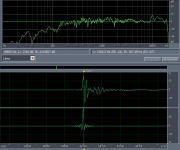
next the to tracks are band pass filtered about 8kHz to 14kHz with 256 point FFT:
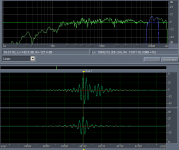
In the above picture the A7.3 is seen to eject secondary pulse of reverse polarity and reduced amplitude roughly 17 samples after primary burst. This corresponds to a distance of about 5 inches. In turn this corresponds to transverse wave propagating from center of cone to edge and back again.
Zooming in on time domain it is seen that multiple bursts of decreasing amplitude are seen at roughly 17 sample intervals:
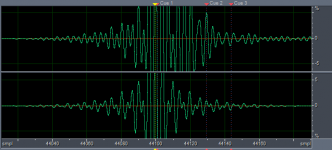
Repeating the exercise with narrow filter centered about 10kHz shows heavy ringing:
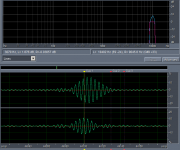

next the to tracks are band pass filtered about 8kHz to 14kHz with 256 point FFT:

In the above picture the A7.3 is seen to eject secondary pulse of reverse polarity and reduced amplitude roughly 17 samples after primary burst. This corresponds to a distance of about 5 inches. In turn this corresponds to transverse wave propagating from center of cone to edge and back again.
Zooming in on time domain it is seen that multiple bursts of decreasing amplitude are seen at roughly 17 sample intervals:

Repeating the exercise with narrow filter centered about 10kHz shows heavy ringing:

IR of A7.3 is placed in stereo track...
With or without the bezel cover?
dave
The IR wav files of A7.3 are from Pnix's data - I would assume he used with bezels otherwise he would have noted it. Pnix can confirm presence of bezel but this ringing is related to the large 12khz breakup peaks that are consistently seen in all frequency redponse measurwments of the A7.3.
With or without the bezel cover?
dave
What difference do you expect between bezel and no bezel?
What difference do you expect between bezel and no bezel?
We do not use the bezel cover because we worry about reflections off the raised edge. Barleywater's analysis shows that they do exist... it is important toknow whether the measures used are with or without.
dave
We do not use the bezel cover because we worry about reflections off the raised edge. Barleywater's analysis shows that they do exist... it is important toknow whether the measures used are with or without.
dave
Those measurements were done without the bezel. The problem is the driver itself.
Those measurements were done without the bezel. The problem is the driver itself.
How wide a baffle, and how deep the box (if one was used)? With supplied data early reflections from small box could account for some of what is seen with measurements and various stimuli.
- Status
- This old topic is closed. If you want to reopen this topic, contact a moderator using the "Report Post" button.
- Home
- Loudspeakers
- Full Range
- Usefulness of In-Room LF Measurements vs. No Measurements (ref FH)